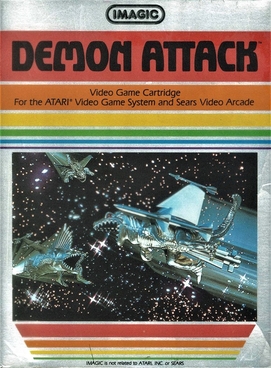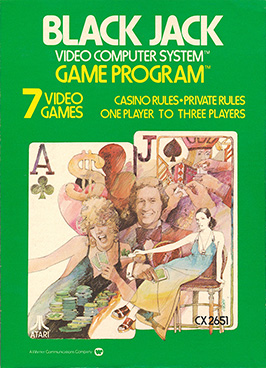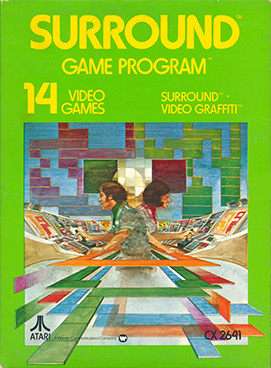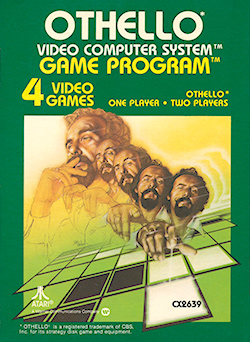
The Atari 2600 is a home video game console developed and produced by Atari, Inc. Released in September 1977 as the Atari Video Computer System, it popularized microprocessor-based hardware and games stored on swappable ROM cartridges, a format first used with the Fairchild Channel F in 1976. The VCS was bundled with two joystick controllers, a conjoined pair of paddle controllers, and a game cartridge—initially Combat and later Pac-Man. Sears sold the system as the Tele-Games Video Arcade. Atari rebranded the VCS as the Atari 2600 in November 1982 alongside the release of the Atari 5200.

Kaboom! is an action video game published in 1981 by Activision for the Atari 2600. The gameplay was based on the Atari arcade video game Avalanche (1978), with the game now involving a Mad Bomber who drops bombs instead of falling rocks. Kaboom! was programmed by Larry Kaplan with David Crane coding the graphics for the buckets and Mad Bomber. It was the last game designed by Kaplan for Activision, who left the company shortly after the release of the game. The game was later ported by Paul Wilson for the Atari 5200 system.

Solaris is a space combat video game for the Atari 2600 published in 1986 by Atari. The game involves a player seeking out the planet Solaris via their starship. To accomplish this, the player must navigate the galactic scanner to explore quadrants of a map. Doing so allows them to explore Federation planets to refuel their ship, and engage in combat with hostile aliens known as the Zylons.

Combat is a 1977 video game by Atari, Inc. for the Atari Video Computer System. In the game, two players controlling either a tank, a biplane, or a jet fire missiles at each other for two minutes and sixteen seconds. Points are scored by hitting the opponent, and the player with the most points when the time runs out wins. Variations on the gameplay introduce elements such as invisible vehicles, missiles that ricochet off of walls, and different playing fields.

Demon Attack is a fixed shooter video game created by Rob Fulop for the Atari 2600 and published by Imagic in 1982. The game involves the player controlling a laser cannon from the surface of a planet, shooting winged demons that fly down and attack the player in different sets of patterns.

Haunted House is a 1982 adventure video game programmed by James Andreasen for the Atari Video Computer System and published by Atari. The player controls an avatar shaped like a pair of eyes who explores a mansion seeking out parts of an urn to return to the entrance. The game world is populated by roaming enemies including vampire bats, tarantulas, and a ghost. Haunted House was among the first games to use player-controlled scrolling between large portions of the visual space.

Pitfall II: Lost Caverns is a video game developed by David Crane for the Atari 2600. It was released in 1984 by Activision. The player controls Pitfall Harry, who must explore in wilds of Peru to find the Raj Diamond, and rescue his niece Rhonda and their animal friend Quickclaw. The game world is populated by enemies and hazards that variously cause the player to lose points and return to a checkpoint.

Air-Sea Battle is a fixed shooter developed and published by Atari, Inc. for the Atari VCS. Air-Sea Battle is partially based on the 1975 Atari arcade video game Anti-Aircraft where each player uses a ground-based gun to shoot passing aircraft. The cartridge adds other variants, such as planes dropping bombs on ships and a carnival-themed shooting gallery.

In the history of video games, the second-generation era refers to computer and video games, video game consoles, and handheld video game consoles available from 1976 to 1992. Notable platforms of the second generation include the Fairchild Channel F, Atari 2600, Intellivision, Odyssey 2, and ColecoVision. The generation began in November 1976 with the release of the Fairchild Channel F. This was followed by the Atari 2600 in 1977, Magnavox Odyssey² in 1978, Intellivision in 1980 and then the Emerson Arcadia 2001, ColecoVision, Atari 5200, and Vectrex, all in 1982. By the end of the era, there were over 15 different consoles. It coincided with, and was partly fuelled by, the golden age of arcade video games. This peak era of popularity and innovation for the medium resulted in many games for second generation home consoles being ports of arcade games. Space Invaders, the first "killer app" arcade game to be ported, was released in 1980 for the Atari 2600, though earlier Atari-published arcade games were ported to the 2600 previously. Coleco packaged Nintendo's Donkey Kong with the ColecoVision when it was released in August 1982.

Basic Math is an educational video game for the Atari Video Computer System. The game was developed at Atari, Inc. by Gary Palmer. The game involves a series of ten arithmetic problems involving addition, subtraction, multiplication, or division. The player can edit different gameplay modes to alter how the numbers in the problem are chosen, or if their questions are timed. The game was released in 1977 as one of the earliest releases for the console.

Blackjack is a video game simulation of the card game blackjack. It was designed by Bob Whitehead for the Atari Video Computer System. The game allows up to three players to play a variation of blackjack. Each player is given 200 chips where they can bet 1 to 25 of each round. The game ends for a player when they either run out of chips or earns 1000 chips or more.

Pac-Man is a 1982 maze video game developed and published by Atari, Inc. under official license by Namco, and an adaptation of the 1980 hit arcade game of the same name. The player controls the title character, who attempts to consume all of the wafers in a maze while avoiding four ghosts that pursue him. Eating flashing wafers at the corners of the screen causes the ghosts to temporarily turn blue and flee, allowing Pac-Man to eat them for bonus points. Once eaten, a ghost is reduced to a pair of eyes, which return to the center of the maze to be restored.

Superman is a video game programmed by John Dunn for the Atari Video Computer System and released in 1979 by Atari, Inc. The player controls Superman, whose quest is to explore an open-ended environment to find three pieces of a bridge that was destroyed by Lex Luthor, capture Luthor and his criminal gang, and return to the Daily Planet building. The game world is populated by antagonists such as a helicopter that re-arranges the bridge pieces and roving kryptonite satellites that cause Superman to revert into Clark Kent.

Surround is a video game programmed by Alan Miller and published by Atari, Inc. for the Atari 2600. The game plays similarly to the arcade game Blockade (1976), which allows players to navigate a continuously moving block around an enclosed space as a wall trails behind it. Every time the opposite player has their brick hit a wall, the opposing player earns a single point, with the winner being the first to collect ten points.

Miniature Golf is a golf video game developed for the Atari VCS by Tom Reuterdahl and published by Atari, Inc. in 1979.

Home Run is a 1978 sports video game developed and published by Atari, Inc. for the Atari Video Computer System. It was the first baseball-themed game released for an Atari platform. The game received mostly negative critical reception due to its unrealistic portrayal of the sport. It was one of the games used by console competitor Mattel to show the quality improvement of Intellivision sports games over the Atari VCS.

Othello is a 1980 video game developed and published by Atari, Inc. for its Atari Video Computer System. It is based on the variant of Reversi of the same name, originally created in 1971. The VCS game was programmed by Ed Logg and Carol Shaw.

RealSports Baseball is a 1982 sports video game developed and published by Atari, Inc. originally for the Atari 2600. It was also launched on the Atari 5200 and 7800 machines. A version for the Atari 8-bit family of home computers was also in development, but it was cancelled.

Video Checkers is a video game developed and published by Atari, Inc. in 1980 for the Atari VCS, renamed to Atari 2600.

Space Invaders is a 1980 video game based on Taito's arcade game of the same name for the Atari 2600. It was developed and released by Atari, Inc. and designed and developed by Rick Maurer. The game is based on the arcade game in which a player operates a laser cannon to shoot at incoming enemies from outer space. Maurer's version has unique graphics and offers some gameplay variations. These include a two-player mode and variations that allow for invisible enemies and moving shields, and for enemies shots to zig zag and potentially hit players.




















